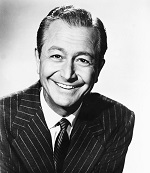
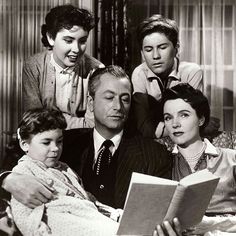 Father Knows Best (1949-1954) aired “Party Preparations” on December 28, 1950 as the 62nd of its 217 episodes. Carried by the NBC Radio network, it starred film star Robert Young (1907-1998, photo at left), who would later also star in the beloved tv series (1954-1960) of the same name. The radio show features a “typical” suburban midwestern American family, the Andersons, where the father (Jim) is an insurance salesman, his wife (Margaret) is a homemaker, and their three children are Bud and Betty–both teenagers with Betty the slightly older–and younger sibling Kathy. The photo at right is of the television Anderson family, and from left to right we have Lauren Chapin as Kathy, Elinor Donahue as Betty, Billy Gray as Bud, and film star Jane Wyatt as Margaret with Robert Young as Jim Anderson reading to his loving family. While both the radio and television shows were hits and retained the basic family structure and setting (the generic town of Springfield with house being on a generic Maple Street), a few things differed when the show moved to television. First, Robert Young was the only member of the radio cast to make the transition to the tv show; and second, at his specific request the father’s character became softer, less irritable and hard-nosed, becoming warmer and gentler, a more thoughtful and wise father than portrayed on radio, the one thing he actively disliked about the show. It worked, of course, and the television show became one of the most fondly remembered family sitcoms ever to air on tv. Of peripheral interest for fans of the show and other tv shows of the 1950s and into the mid-1960s is that the Anderson’s middle American house was also the same house repurposed for the Dennis the Menace show (1959-63), and later as the home of Major Nelson (played by Larry Hagman) for I Dream of Jeannie (1965-70, starring Barbara Eden).
Father Knows Best (1949-1954) aired “Party Preparations” on December 28, 1950 as the 62nd of its 217 episodes. Carried by the NBC Radio network, it starred film star Robert Young (1907-1998, photo at left), who would later also star in the beloved tv series (1954-1960) of the same name. The radio show features a “typical” suburban midwestern American family, the Andersons, where the father (Jim) is an insurance salesman, his wife (Margaret) is a homemaker, and their three children are Bud and Betty–both teenagers with Betty the slightly older–and younger sibling Kathy. The photo at right is of the television Anderson family, and from left to right we have Lauren Chapin as Kathy, Elinor Donahue as Betty, Billy Gray as Bud, and film star Jane Wyatt as Margaret with Robert Young as Jim Anderson reading to his loving family. While both the radio and television shows were hits and retained the basic family structure and setting (the generic town of Springfield with house being on a generic Maple Street), a few things differed when the show moved to television. First, Robert Young was the only member of the radio cast to make the transition to the tv show; and second, at his specific request the father’s character became softer, less irritable and hard-nosed, becoming warmer and gentler, a more thoughtful and wise father than portrayed on radio, the one thing he actively disliked about the show. It worked, of course, and the television show became one of the most fondly remembered family sitcoms ever to air on tv. Of peripheral interest for fans of the show and other tv shows of the 1950s and into the mid-1960s is that the Anderson’s middle American house was also the same house repurposed for the Dennis the Menace show (1959-63), and later as the home of Major Nelson (played by Larry Hagman) for I Dream of Jeannie (1965-70, starring Barbara Eden).

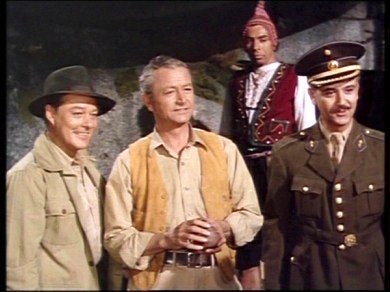 Interesting also is that after having roles, or starring (many times as the handsome male lead), in over 100 films dating from the 1930s, Robert Young made a conscious decision to quit his film career in 1954, and almost immediately after the demise of Father Knows Best on radio in 1954 was one of the prime movers in getting the show on television, and in the same year. He never looked back, having become thoroughly disgusted with how Hollywood worked and how it treated most of its actors. Coincidentally, his final film in 1954 was Secret of the Incas starring Charlton Heston (Heston, photo at left; Young in center of photo at right). If ever there was a precursor or model for the Indiana Jones films, this was surely it. Heston plays Harry Steele in Secret of the Incas as a pilot, adventurer, and tour guide in Peru, who then gets involved in attempting to find a “golden starburst” relic stolen from the ancient Temple of the Sun, believed to have the power to restore the once proud Incan civilization. Lux Radio Theater ran an hour long dramatization of the film in December of 1954 with most of the major film actors reprising their roles. We ran this episode in August of 2013–replete with color film stills with Heston in his (what would become) iconic Indiana Jones Adventurer garb here.
Interesting also is that after having roles, or starring (many times as the handsome male lead), in over 100 films dating from the 1930s, Robert Young made a conscious decision to quit his film career in 1954, and almost immediately after the demise of Father Knows Best on radio in 1954 was one of the prime movers in getting the show on television, and in the same year. He never looked back, having become thoroughly disgusted with how Hollywood worked and how it treated most of its actors. Coincidentally, his final film in 1954 was Secret of the Incas starring Charlton Heston (Heston, photo at left; Young in center of photo at right). If ever there was a precursor or model for the Indiana Jones films, this was surely it. Heston plays Harry Steele in Secret of the Incas as a pilot, adventurer, and tour guide in Peru, who then gets involved in attempting to find a “golden starburst” relic stolen from the ancient Temple of the Sun, believed to have the power to restore the once proud Incan civilization. Lux Radio Theater ran an hour long dramatization of the film in December of 1954 with most of the major film actors reprising their roles. We ran this episode in August of 2013–replete with color film stills with Heston in his (what would become) iconic Indiana Jones Adventurer garb here.
It would seem that Robert Young himself, with his role in both the radio and tv versions of Father Knows Best, the factoid about his final film role having a link to the future Indiana Jones films, and the home of the television version of the show having ties to two other famous tv sitcoms, would be enough to help fuel cocktail party conversations should the need arise to help fill any inevitable voids (and there is much more of interest surrounding the show and Young that could be told). Suffice it to say that both radio and television versions of Father Knows Best, in different ways for individual people or entire families, touched enough emotional chords to make the show one of the most iconic representations of an idealized midwestern family ever shown. It has been released in tv reruns on numerous stations over the ensuing decades, and even now can be seen daily on the OTA (Over The Air) Antenna TV network.
“Party Preparations” takes place on New Year’s Eve and begins with Jim winning a very large turkey in a raffle. A live turkey. Complications build quickly on top of one another until the entire Anderson family discovers that the best laid plans of men and the Andersons gang aft agley. It’s a typical everything-goes-wrong-at-once scenario I’m sure many a family on New Year’s Eve has in one way or another experienced at least once. Of coincidental note is that it originally aired exactly 69 years ago to the date of this December 28, 2019 reprise. Enjoy.
Play Time: 29:38
{What came to be known as the “western” was so integral a part of the American experience that it found itself over time a major driving force of the media, with western movies a staple of the big screen, a number of radio programs dedicated to the western and starring many a big screen film star prevalent over America’s air waves, western novels a commonplace of the print industry, and pulp magazines devoted to the western experience numbering in the many dozens for almost 75 years dating from the early 1900s found eager audiences of all ages. (It wouldn’t be until the early 1950s and especially the late 1950s that the western would come to dominate the new medium of television alongside detective and police procedural programming.) So it was little wonder that from time to time the neighborhood gang would take a break from their first love, the SF pulps, and turn to the ever-reliable Western pulp magazines to sate their lust for page-turning adventure; the Western, where there were clear-cut Good Guys and Bad Guys of various stripes involved in all kinds of dramatic and often violent tales as the taming of he West was an endless resource for skilled storytellers, and where even the western-themed romance magazine found a home. All-Story Western (1949-51) only lasted 14 issues but when it appeared seemed to satisfy the easy to root for Hero who gave no quarter in taking care of the evil Villain or Villains. In 1950 it was a bi-monthly. One of the young neighorhood cowpokes owed his sister a favor, which she called in by asking him to pick up a Romance titles for her. Little did she imagine it would be, of all things, a western romance magazine, a sub-genre with which she had no previous experience. Ranch Romances (1924-71) was a highly popular publication (possibly because its audience was primarily female), offering two issues a month for nearly all of its first 33 years until 1958. From 1959 until its demise it held to a quarterly schedule. Western Short Stories (1936-44, 1947-57), though it went on a three year hiatus in the mid-1940s, yet managed close to a 20-year net run, no doubt helped by giving its readers their money’s worth with 15 stories an issue. With a generally sporadic schedule, it managed 5 issues in 1950.]
[Left: All-Story Western, Nov. 1950 – Center: Ranch Romances, mid-Dec. 1950 – Right: Western Short Stories, Nov. 1950]
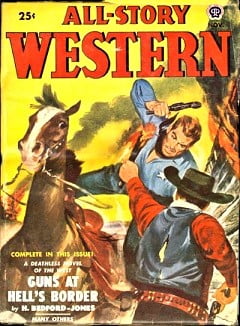
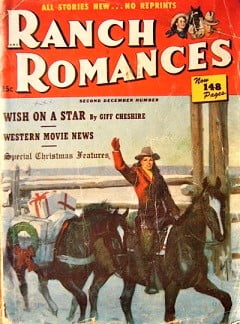
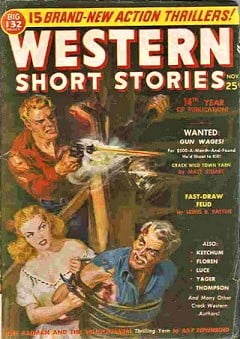
To view the entire list of weekly Old Time Radio episodes at Tangent Online, click here.